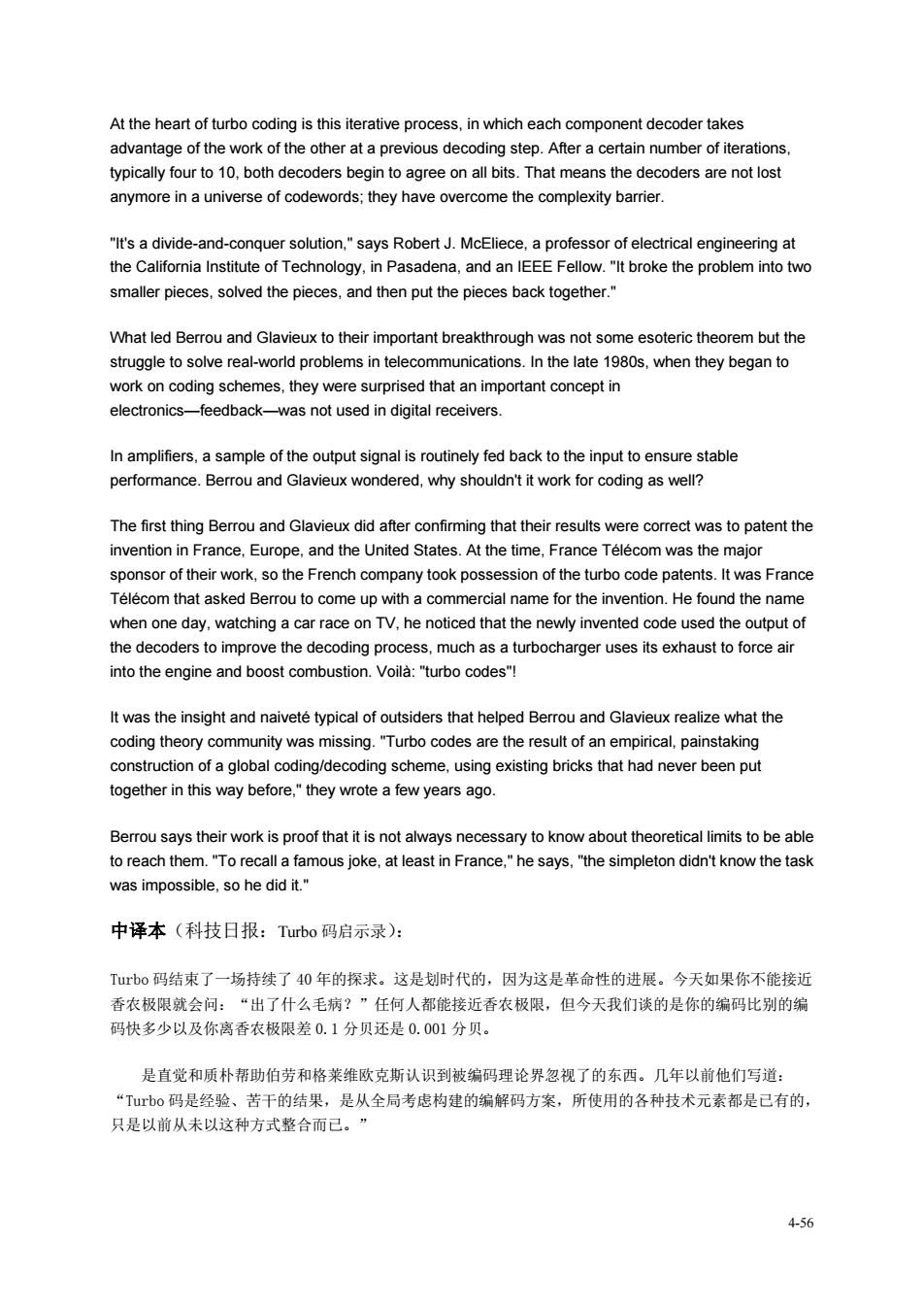正在加载图片...

At the heart of turbo coding is this iterative process,in which each component decoder takes advantage of the work of the other at a previous decoding step.After a certain number of iterations anymore in a universe of codewords;they have overcome the complexity barrie "It's a divide-and-conquer solution,"says Robert J.McEliece,a professor of electrical engineering at the California Institute of Technology,in Pasadena,and an IEEE Fellow."It broke the problem into two smaller pieces,solved the pieces.and then put the pieces back together. What led Berrou and Glavieux to their important breakthrough was no oteric theorem but the struggle to solve real-world problems in telecommunications.In the late 1980s.when they began to work on coding schemes,they were surprised that an important concept in electronics-feedback-was not used in digital receivers. In amplifiers.a sample of the output signal is routinely fed back to the input to ensure stable performance.Berrou and Glavieux wondered,why shouldn't it work for coding as well? The first thing Berr and Gla auy did a舟a that the results was to patent the sponsor of their work.so the French company took possession of the turbo code patents.It was France Telecom that asked Berrou to come up with a commercial name for the invention.He found the name when one day.watching a car race on TV.he noticed that the newty invented code used the output of the decoders to improve the decoding p ocess.much as a turbocharger uses its exhaust to force air into the engine and boost combustion.Voila:"turbo codes" It was the insight and naivet typical of outsiders that helped Berrou and Glavieux realize what the coding theory community was missing."Turbo codes are the result of an empirical,painstaking construction of a global coding/decoding scheme,using existing bricks that had never been put together in this way before."they wrote a few years ago usays their work is proof ys nece ssary to know about th oret tical limits tobe able reacthemTorafmous ioke.at leastFnhesavs.the simpleton didntknow the task was impossible,so he did it.' 中译本(科技日报:Tubo码启示录): Trb©码结束了一场持续了40年的探求。这是划时代的,因为这是革命性的进展。今天如果你不能接近 香衣极限就会 “出了什么毛病?”任何人都能接 近香农极限,但今天我们谈的是你的编码比别的编 码快多少以及你离香农极限差0.1分贝还是0.001分贝。 是直觉和质朴帮助伯劳和格菜维欧克斯认识到被编码理论界忽视了的东西。几年以前他们写道: “Tb0码是经验、苦干的结果,是从全局考虑构建的编解码方案,所使用的各种技术元素都是已有的, 只是以前从未以这种方式整合而已,” 4564-56 At the heart of turbo coding is this iterative process, in which each component decoder takes advantage of the work of the other at a previous decoding step. After a certain number of iterations, typically four to 10, both decoders begin to agree on all bits. That means the decoders are not lost anymore in a universe of codewords; they have overcome the complexity barrier. "It's a divide-and-conquer solution," says Robert J. McEliece, a professor of electrical engineering at the California Institute of Technology, in Pasadena, and an IEEE Fellow. "It broke the problem into two smaller pieces, solved the pieces, and then put the pieces back together." What led Berrou and Glavieux to their important breakthrough was not some esoteric theorem but the struggle to solve real-world problems in telecommunications. In the late 1980s, when they began to work on coding schemes, they were surprised that an important concept in electronics—feedback—was not used in digital receivers. In amplifiers, a sample of the output signal is routinely fed back to the input to ensure stable performance. Berrou and Glavieux wondered, why shouldn't it work for coding as well? The first thing Berrou and Glavieux did after confirming that their results were correct was to patent the invention in France, Europe, and the United States. At the time, France Télécom was the major sponsor of their work, so the French company took possession of the turbo code patents. It was France Télécom that asked Berrou to come up with a commercial name for the invention. He found the name when one day, watching a car race on TV, he noticed that the newly invented code used the output of the decoders to improve the decoding process, much as a turbocharger uses its exhaust to force air into the engine and boost combustion. Voilà: "turbo codes"! It was the insight and naiveté typical of outsiders that helped Berrou and Glavieux realize what the coding theory community was missing. "Turbo codes are the result of an empirical, painstaking construction of a global coding/decoding scheme, using existing bricks that had never been put together in this way before," they wrote a few years ago. Berrou says their work is proof that it is not always necessary to know about theoretical limits to be able to reach them. "To recall a famous joke, at least in France," he says, "the simpleton didn't know the task was impossible, so he did it." 中译本(科技日报:Turbo 码启示录): Turbo 码结束了一场持续了 40 年的探求。这是划时代的,因为这是革命性的进展。今天如果你不能接近 香农极限就会问:“出了什么毛病?”任何人都能接近香农极限,但今天我们谈的是你的编码比别的编 码快多少以及你离香农极限差 0.1 分贝还是 0.001 分贝。 是直觉和质朴帮助伯劳和格莱维欧克斯认识到被编码理论界忽视了的东西。几年以前他们写道: “Turbo 码是经验、苦干的结果,是从全局考虑构建的编解码方案,所使用的各种技术元素都是已有的, 只是以前从未以这种方式整合而已